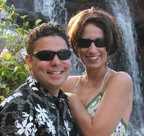There was a time months ago that it didn't exist, so when I see my son growing with 'pretend play', it makes me burst with pride.
This morning, he was gathering objects in his little shopping cart from around the house. He placed them all on the counter of the play kitchen we have. He grabbed his pretend cash register, equipped with scanner, and proceeded to scan each item and then throw them in the shopping cart. I asked him what he was doing and he said "shopping at Vons". About a minute later he said he was "paying" and then pushed the cart really fast down the hallway, saying "bye mommy, I'm going home"!
He was so excited, but I think I was more.
Saturday, March 7, 2009
Tuesday, March 3, 2009
Occupational Therapy
I am often asked what Occupational Therapy is, so I thought I'd go into detail in today's blog post.
Occupational Therapy, also known as OT, (according to Wikipedia) incorporates meaningful and purposeful occupation to enable people with limitations or impairments to participate in everyday life.
According to About.com, Occupational Therapy actually deals with strengthening fine motor skills, like writing, cutting, shoe-tying and using utensils. For adults recovering from an accident or stroke, that may include work-related skills; for children, whose "occupation" is school and play, it will focus more sharply on developmental milestones and skills required for playground and academic activities. Occupational therapists working with children typically use techniques and routines that may seem like play, but are designed to target areas of delay and difficulty. Some occupational therapists are also trained in therapy with a sensory integration approach (SI), which uses play-like activities to help children better process and tolerate the information they get through their senses.
John would spend his hour of OT swinging on different types of swings, climbing, working through obstacle courses, hanging on a trapeze bar, jumping in ball pit, jumping on trampoline, walking on different textures, riding a tricycle, throwing balls, working on fine motor skills, and sometimes, working on eating issues.
Occupational Therapy, also known as OT, (according to Wikipedia) incorporates meaningful and purposeful occupation to enable people with limitations or impairments to participate in everyday life.
According to About.com, Occupational Therapy actually deals with strengthening fine motor skills, like writing, cutting, shoe-tying and using utensils. For adults recovering from an accident or stroke, that may include work-related skills; for children, whose "occupation" is school and play, it will focus more sharply on developmental milestones and skills required for playground and academic activities. Occupational therapists working with children typically use techniques and routines that may seem like play, but are designed to target areas of delay and difficulty. Some occupational therapists are also trained in therapy with a sensory integration approach (SI), which uses play-like activities to help children better process and tolerate the information they get through their senses.
John would spend his hour of OT swinging on different types of swings, climbing, working through obstacle courses, hanging on a trapeze bar, jumping in ball pit, jumping on trampoline, walking on different textures, riding a tricycle, throwing balls, working on fine motor skills, and sometimes, working on eating issues.
Monday, March 2, 2009
Neuro-Psych Evaluation
To bring everybody up-to-date:
John was diagnosed as "at risk" for autism at 30 months old by Regional Center
When he turned 3, he was evaluated by the school district, who said they do not see a developmental delay or signs of autism that impact education and denied any special educational services.
Regional Center then told us that since he had "provisional" or "at risk" autism to begin with, there never was a diagnosis in the first place.
SO --- we are going through a medical doctor, a neuro-psych to find out if John needs a diagnosis or not. Both Regional Center and the school district determine funding, so we thought we needed another opinion by someone who had nothing to do with funding.
The assessment will consist of parent and teacher questionnaires and interviews, as well as a few days of evaluation of John in different settings and at school, with other kids. We've had 2 sessions already and am looking forward to her assessment.
John was diagnosed as "at risk" for autism at 30 months old by Regional Center
When he turned 3, he was evaluated by the school district, who said they do not see a developmental delay or signs of autism that impact education and denied any special educational services.
Regional Center then told us that since he had "provisional" or "at risk" autism to begin with, there never was a diagnosis in the first place.
SO --- we are going through a medical doctor, a neuro-psych to find out if John needs a diagnosis or not. Both Regional Center and the school district determine funding, so we thought we needed another opinion by someone who had nothing to do with funding.
The assessment will consist of parent and teacher questionnaires and interviews, as well as a few days of evaluation of John in different settings and at school, with other kids. We've had 2 sessions already and am looking forward to her assessment.
Sunday, March 1, 2009
2 new websites
It's been awhile since I've written, but I've come across 2 new websites that I thought were worth mentioning.
http://www.adaptivechild.com/index.html
and
http://www.weightedvestsforchildren.com/weighted-vests-for-children.html
http://www.adaptivechild.com/index.html
and
http://www.weightedvestsforchildren.com/weighted-vests-for-children.html
Subscribe to:
Posts (Atom)



